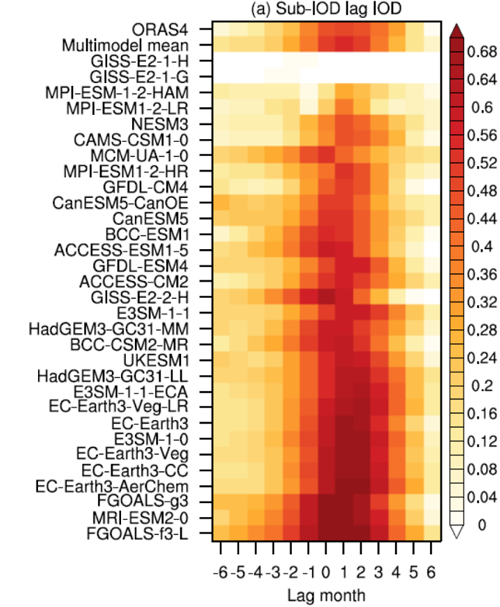中国科学院大气物理研究所大气科学和地球流体力学数值模拟国家重点实验室
State Key Laboratory of Numerical Modeling for Atmospheric Sciences and
Geophysical Fluid Dynamics (LASG)
Institute of Atmospheric Physics, Chinese Academy of Sciences
State Key Laboratory of Numerical Modeling for Atmospheric Sciences and
Geophysical Fluid Dynamics (LASG)
Institute of Atmospheric Physics, Chinese Academy of Sciences

Vol.19/No.19 December 2023
AAS: State-of-the-art Climate Models Overestimate the Coupling between the Subsurface and Surface Indian Ocean Dipoles
Recently, a paper published in Advances in Atmospheric Sciences has revealed that most state-of-the-art climate models tend to overestimate the amplitude and dominant period of the Sub-IOD. By assessing the historical simulations of 31 such models, the researchers also found that the coupling between the Sub-IOD and surface IOD is overly strong owing to a biased much steeper thermocline tilt in most of the models compared with reanalysis data. Moreover, in terms of the different types or "flavors" of ENSO that we now know exist, most models show a much tighter association of the Sub-IOD and IOD with the canonical ENSO (i.e., the classical ENSO type in which the maximum temperature anomalies are found in the eastern Pacific). Plus, the linkage between the more westward-centered Central Pacific type of ENSO and the Sub-IOD that occurs in winter to spring, independent of the IOD, is also well reproduced.
"Our results can potentially lead to more reliable predictions and future projections of regional and global climate," says SONG Ge, from the Institute of Atmospheric Physics at the Chinese Academy of Sciences and lead author of the study.

Lead–lag correlations between the indices of the IOD and Sub-IOD in 31 state-of-the-art climate models and in reanalysis data (ORAS4). Darker colors represent a stronger coupling between the IOD and Sub-IOD (image by SONG Ge).
Citation: Ge, S., and R. C. Ren, 2023: Subsurface and surface Indian Ocean Dipole and their association with ENSO in CMIP6 models. Adv. Atmos. Sci., https://doi.org/10.1007/s00376-022-2086-2 .
Link: https://link.springer.com/article/10.1007/s00376-022-2086-2
Contact: REN Rongcai, rrc@lasg.iap.ac.cn
Add: No.40, Huayanli, Beichen West Road, Chaoyang District, Beijing P.O. Box 9804, 100029, China
E-mail: lasg_newsletter@lasg.iap.ac.cn
Editors: Chuanyi Wang (wangcy@lasg.iap.ac.cn), Kangjun Chen(ckj@lasg.iap.ac.cn)
E-mail: lasg_newsletter@lasg.iap.ac.cn
Editors: Chuanyi Wang (wangcy@lasg.iap.ac.cn), Kangjun Chen(ckj@lasg.iap.ac.cn)